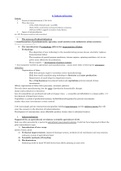6: Industrialisation
Content:
1. Process of industrialisation (1750-1914)
2. Three big waves
- 1780s-1820s: British leader ( and BE)
- 1840s-1870s: acceleration and speed: follower economies
- 1890 and 1900s: Laggard economies: Italy, Russia.
3. Impact of industrialization
(on 19C European societies and economies)
1. The process of industrialisation
= transformation of predominantly agrarian, rural societies into industrial, urban societies.
Roughly accompanied by:
● The introduction of technology affects the organization of labor.
- Technology:
- The adaptation of new technology to the manufacturing process (steam, electricity replaces
human/animal labor).
- The invention of special purpose machinery (steam engines, spinning machines, etc) to use
power more effectively for production.
- Steam engines → development of railway systems.
→ less manpower needed in agriculture and manufacturing. - means more labor is freed up for alternative
industries.
- Organisation of labor:
- Shift from primary (agri) to secondary sector (manufacturing).
- Shift from small manufacturing workshops to factories and mass production.
- Replacement of small shops by department stores.
- Rise of big business (investment banks) and capitalism (private instead of state
investments.
Affects organization of labor, labor processes, consumer patterns.
Not only about manufacturing, but the scale of production dramatically changes.
(large-scale production in factories)
Lots of commodities are produced and sold at cheaper rates. → accessible and affordable to a larger public. ==>
development of department stores.
Capitalism: a system of production/economy, fuelled/directed/organised by private investments.
(rather than state investments or state control)
C19: increasingly, private entrepreneurs/capitalists holding large fortunes and the ability to invest that will
steer the economy in the direction of industrialization.
Development of consumerism, more affordable produce, leisure time in urbanised centres.
1. Industrialisation
Supported by an agricultural revolution: scientific agriculture (C18)
Indn was often preceded by a period of agricultural innovation/revolution. Could not have happened without the
prior innovations in agri.
1) Introduction of new crops
(potato, beans, peas)
2) Technical improvements: improved drainage system, methods of soil enrichment and crop rotation,
enclosure system of agricultural land.
3) Scientific methods of breeding
4) Mechanisation
- Scattering seeds by hand VS drill device that allows planting in neat rows.
, - Farm machinery: the reaper and seed drill.
● Enhanced productivity created surplus labor force.
(available for factory work in urbanized centres)
==> indn: gradual change in Europe only manifesting itself in C19 thanks to agricultural innovations in C18.
2. Three big waves
1) 1780s-1820s: industrial take-off: UK, BE
2) 1840s-1870s: Follower countries: Fr, DL
3) 1870s onwards/1890s-1900s: Laggard countries: Russia, Italy
Ottoman empire: de-industrialisation
● State-led attempts at indn in Egypt (1820s, iron, cotton) but negatively impacted by Muhammad Ali’s
death in 1849.
● Indn affected by political instability and import of (cheap) European goods (reduction of domestic tax
revenues).
○ Growing conflicts and national revolutions in Eastern Europe and Balkan.
○ Loss of revenues because goods don’t need to be produced domestically (because of cheap
imports) - no taxes collected.
● Growing financial control of European powers; forced opening and liberalisation of the market.
○ As a result of the weakening of OE, many European powers are imposing a policy of
liberalisation onto it.
○ European powers interested in the potential huge consumer market, so really push for
liberalization (no protectionism)
○ As a result, very few import tariffs on import of European goods.
○ Meant Europeans could import at a very cheap rate & further reduced the need for OE to
invest in indn.
○ No real protectionism possible due to OE dependency on European powers.
■ Result of warfare and peace treaties and lots of loans of OE with DL, Fr, UK.
■ ==> forced to liberalise their market.
2.1. Wave 1: British leadership: why?
1780s-1820s
1) Resources close to sea: coal and iron (basic necessities of industry) on the seaside ==> easy, cheap
transport.
Iron and coal were located near each other - no need to transport heavy iron across the country } close proximity
to each other allowed for the creation of a factory of metal production in proximity of a coalmine.
(Coal - heat up iron. Iron - metal to produce steel. Steel is strong, durable to make machinery)
- Having the right resources
- Having them in close proximity to each other
- And close to sea
→ ^^ real advantage of the UK
2) Constitutional monarchy and (relative) political stability
Britain already had a longstanding tradition of a constitutional monarchy, was conducive to producing a
relatively stable political climate.
Stability = good when aiming for economic innovations/changes.
3) Economic liberalisation: few state monopolies, positive climate for entrepreneurs, promoted early
applications of technology.




